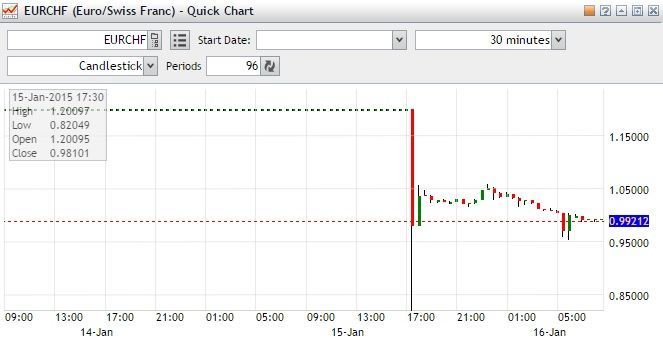- You are here:
- Home »
- Forex
- » EURCHF Carnage as SNF Abandons Euro Floor
EURCHF Carnage as SNF Abandons Euro Floor
Following the decision of Swiss National Bank (SNF) to abandon their 3-year 1.20 Euro currency floor, the value of EUR/CHF collapsed in a matter of minutes. This is how the hourly chart looks like with the low of 0.82 off the charts….
Besides abandoning the floor, the SNF also cut interest rates from -0.25% to -0.75%.
SNF apparently decided to do 2 out of the 3 things they could have done as highlighted in this article from Saxo.
SNB faces classic ‘trilemma’ as EURCHF floor nears
That article was written in 3Q2014 so please ignore the trading calls at the end.
Kathy Lien wrote an article on how the move by SNB might affect the various currency pairs and asset classes.
For those who trade forex, you will know that a 30,000+ (typo) 3000+ pips movement in a matter of minutes is no laughing matter. This is the type of seismic movement that will either blow your trading account or make you a fortune. The Swiss Market Index was also down 8.7% at the end of the day, dropping by as much as 14% intraday.
Following the announcement by SNF, I received a couple of emails from trading platform providers with this message:
Due to today’s exceptional market movement in CHF crosses, we have been filling client orders and positions in an extremely illiquid market.
Once we are better able to establish true market liquidity, all executed fills will be revisited, and will be revised and amended to more accurate levels. This may result in a worse execution rate than the originally filled level.
What this means is that those who had a CHF trade executed during the period of volatility might have their price adjusted.
This is one big thing that I don’t like about trading Over The Counter (OTC) products. Your counter-party is essentially your platform provider and he is at liberty to do things as adjusting your prices without warning.
Imagine having the first leg of a trade done at a particular price but then being told afterwards that the price will be adjusted and made known to you at a later date. How are you going to manage the position?
Furthermore, your losses are the platform provider’s gains and vice versa. Trading with stop-losses in place is like playing poker with an opponent who can see your cards and knows when you will fold. That makes it more difficult to win.
A solution to this would be to use exchange traded products. For forex, this would be forex futures.
Another thing about yesterday’s movement is that stop losses would not have protected you fully due to the gap down in prices. This would have been the case whether you were trading using an OTC product or forex futures.
However, in the case of forex futures, at least you know that whatever price your trade was executed would be the price that you get. For OTC, what you see might not be what you get.
Trade with care.

